The ASTI Data in Focus series provides additional background data in support of the 2010 Country Note on Côte d'Ivoire (asti.cgiar.org/pdf/CotedIvoire-Note.pdf) prepared by the Agricultural Science and Technology Indicators (ASTI) initiative and the National Center for Agricultural Research (CNRA). Based on data collected by ASTI and CNRA, these two outputs review major investment and capacity trends in Ivorian public agricultural research and development (R&D) since 1981, providing important updates on agricultural R&D trends prepared by ASTI in 2000 - 03.
C. Human Resources
This section provides detailed quantitative information on trends in full-time equivalent (FTE) agricultural research and support staff, including qualifications, gender, and support-staff-per-researcher ratios. Supplementary sections present detailed data on long-term trends (Section A), financial resources (Section B), and research allocation (Section D). Other supporting information provides macroeconomic trends, a list of agencies included in the study, data sources and estimation procedures, and ASTI's methodology.
Table C1 -- Total researcher levels across various agencies, 2008
CNRA's research capacity slightly decreased during 2001 - 08, from 86 to 81 FTE researchers. This decrease was accompanied by an increase in the share of PhD-qualified researchers. In 2001, 41 percent of FTE researchers at CNRA held PhD degrees, compared with 53 percent in 2008. No researchers at CNRA held BSc degrees only during this period, but -- like other agencies in Côte d'Ivoire -- CNRA does employ technicians qualified to the BSc (or equivalent) level who are not officially classified as researchers (see Figure C5). Agency
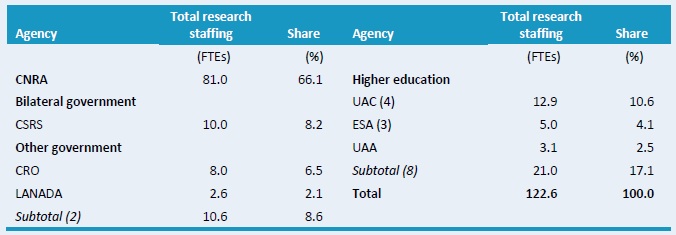
Source: Calculated by authors from ASTI - CNRA 2009.
Notes: Figures in parentheses indicate the number of agencies in each category. For more information on coverage and estimation procedures, see the Côte d'Ivoire's country page on ASTI's website at asti.cgiar.org/cote-divoire/datacoverage].
Figure C1 -- Research staff trends at CNRA by degree (in full-time equivalents), 2001 - 08
CNRA's research capacity slightly decreased during 2001 - 08, from 86 to 81 FTE researchers. This decrease was accompanied by an increase in the share of PhD-qualified researchers. In 2001, 41 percent of FTE researchers at CNRA held PhD degrees, compared with 53 percent in 2008. No researchers at CNRA held BSc degrees only during this period, but -- like other agencies in Côte d'Ivoire -- CNRA does employ technicians qualified to the BSc (or equivalent) level who are not officially classified as researchers (see Figure C5).
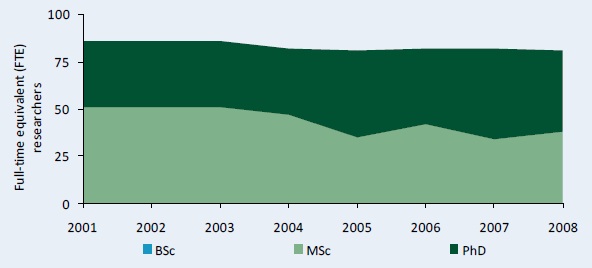
Sources: Calculated by authors from Stads and Beintema 2003 and ASTI - CNRA 2009.
Notes: Research staff excludes expatriate staff working at CNRA. For more information on coverage and estimation procedures, see the Cote d'Ivoire country page on ASTI's website at asti.cgiar.org/cote-divoire/datacoverage.
Figure C2 -- Full-time equivalent researcher trends at seven higher education agencies by degree, 2001 - 08
From 2001 to 2008, the number of researchers employed at the higher education agencies increased from 8 to 13 FTEs. Consistent with the trend at CNRA, researchers at higher education agencies also upgraded their qualifications during this period. The number of researchers with PhD degrees increased from 5 to 9 FTEs, the number of researchers with MSc degrees increased from 2 to 4 FTEs, and the number of BSc-qualified researchers remained more or less constant.
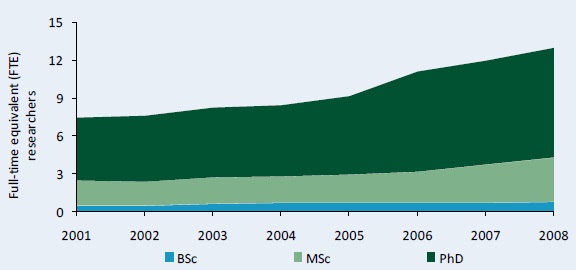
Sources: Calculated by authors from Stads and Beintema 2003 and ASTI - CNRA 2009.
Note: Research staff excludes the Faculty of Science and Technology under the University of Cocody-Abidjan (FAST-UAC) because data were not available.
Figure C3 -- Distribution of researcher qualifications across agencies, 2008
On average, 69 percent of researchers employed at the higher education agencies held PhD degrees. The University Abobo-Adjamé (UAA) and Oceanological Research Center (CRO) employed the highest share of PhD researchers, at 95 and 94 percent, respectively. The National Laboratory for Agricultural Development (LANADA) reported the highest share of BSc-qualified researchers at 53 percent.
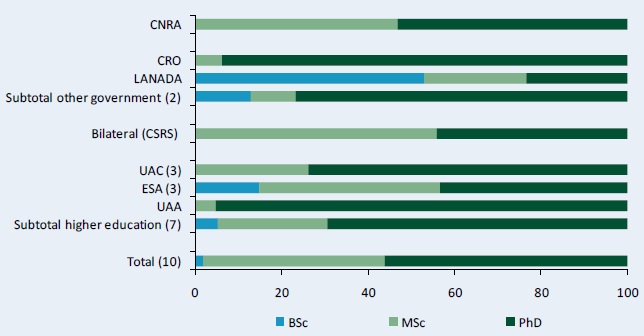
Sources: Calculated by authors from Stads and Beintema 2003 and ASTI - CNRA 2009.
Note: Figures in parentheses indicate the number of agencies in each category.
Figure C4 -- Share of female researchers at CNRA by degree, 2001 and 2008
The share of female researchers at CNRA increased by one percentage point during 2001 - 08 (from 9 to 10 percent), but female researchers are very much underrepresented in Ivorian agricultural R&D. Across qualification levels, the share of women increased from 10 to 13 percent among MSc-qualified researchers, and slightly decreased among PhD-qualified researchers.
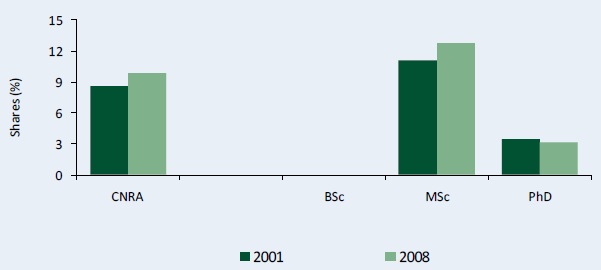
Sources: Calculated by authors from Stads and Beintema 2003 and ASTI - CNRA 2009.
Note: CNRA was the only agency for which 2001 and 2008 gender data were available.
Figure C5 -- Trends in degree-qualified full-time equivalent researchers and technicians at the government agencies, 2004 - 08
Agricultural R&D agencies in Côte d'Ivoire employ large numbers of degree-qualified FTE technicians who are not officially classified as researchers. The number of FTE technicians at the government agencies, especially at CRO and LANADA, grew during 2004 - 08, and in 2008 CNRA, CRO, and LANADA together employed 4 FTE technicians with MSc degrees and 12 with BSc degrees.
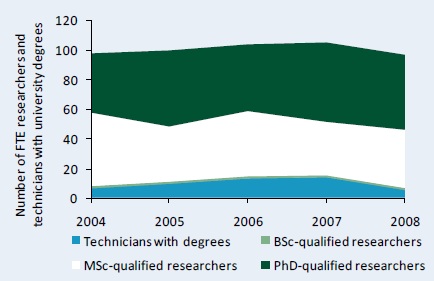
Source: Calculated by authors from ASTI - CNRA 2009.
Figure C6 -- Trends in full-time equivalent support staff, 2001 - 08
Support staff numbers fell during 2001 - 08, from 2,225 to 1,960 FTEs. Of these, other support staff accounted for the largest share, at 67 percent in 2008, which is high compared with other African countries. The fact that many CNRA employees spend some of their time contributing to the Center's cocoa or coffee production schemes likely explains this discrepancy.
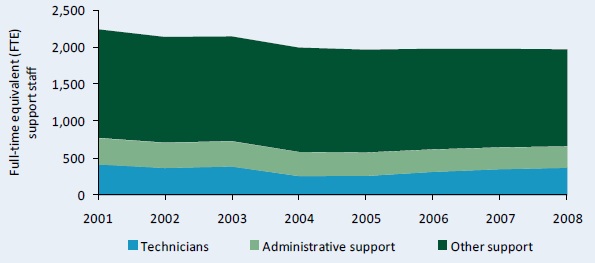
Sources: Calculated by authors from Stads and Beintema 2003 and ASTI - CNRA 2009.
Figure C7 -- Support-staff-per-researcher ratios by institutional category, 2001 and 2008
From 2001 to 2008, overall support-staff-per-researcher ratios increased slightly from 17 to 18 FTEs -- one of the highest ratios in Sub-Saharan Africa. CNRA was responsible for this, reporting a ratio of 24 FTE support-staff-per-researcher in 2008, again most likely due to staff participation in cocoa and coffee production schemes. Unsurprisingly, the higher education agencies reported the lowest support-staff-per-researcher ratio, which is common given that research is a secondary mandate.
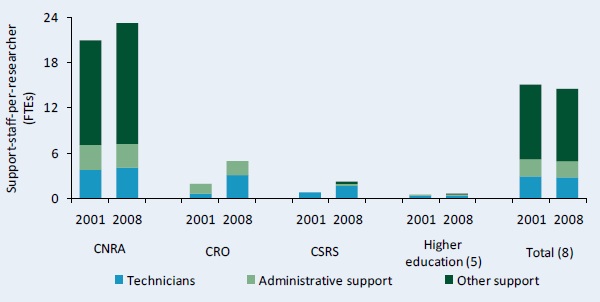
Sources: Calculated by authors from Stads and Beintema 2003 and ASTI - CNRA 2009.
Notes: Figures in parentheses indicate the number of agencies in each category. For more information on coverage and estimation procedures, see the Cote d'Ivoire country page on ASTI's website at asti.cgiar.org/cote-divoire/datacoverage.
Copyright (C) 2011 International Food Policy Research Institute (IFPRI) and National Center for Agricultural Research (CNRA). Sections of this Data in Focus issue may be reproduced without the express permission of, but with acknowledgment to, IFPRI and CNRA. This series has been prepared as an output for the ASTI initiative and has not been peer reviewed. Any opinions stated herein are those of ASTI and do not necessarily reflect the policies and opinions of IFPRI or CNRA.
